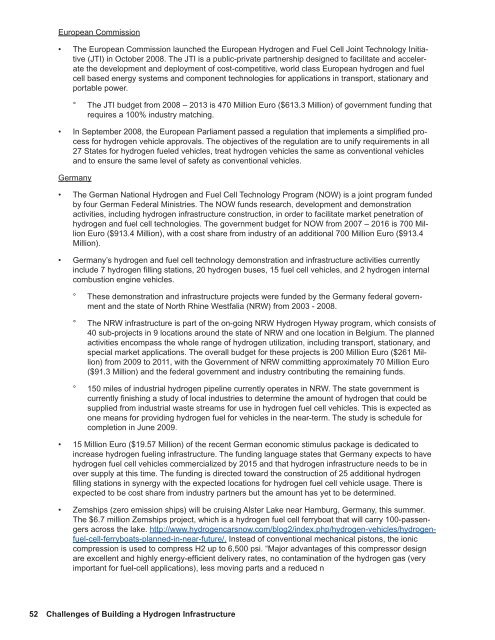Challenges - Research and Innovative Technology Administration ...
Challenges - Research and Innovative Technology Administration ...
Challenges - Research and Innovative Technology Administration ...
You also want an ePaper? Increase the reach of your titles
YUMPU automatically turns print PDFs into web optimized ePapers that Google loves.
European Commission<br />
• The European Commission launched the European Hydrogen <strong>and</strong> Fuel Cell Joint <strong>Technology</strong> Initiative<br />
(JTI) in October 2008. The JTI is a public-private partnership designed to facilitate <strong>and</strong> accelerate<br />
the development <strong>and</strong> deployment of cost-competitive, world class European hydrogen <strong>and</strong> fuel<br />
cell based energy systems <strong>and</strong> component technologies for applications in transport, stationary <strong>and</strong><br />
portable power.<br />
°°<br />
The JTI budget from 2008 – 2013 is 470 Million Euro ($613.3 Million) of government funding that<br />
requires a 100% industry matching.<br />
• In September 2008, the European Parliament passed a regulation that implements a simplified process<br />
for hydrogen vehicle approvals. The objectives of the regulation are to unify requirements in all<br />
27 States for hydrogen fueled vehicles, treat hydrogen vehicles the same as conventional vehicles<br />
<strong>and</strong> to ensure the same level of safety as conventional vehicles.<br />
Germany<br />
• The German National Hydrogen <strong>and</strong> Fuel Cell <strong>Technology</strong> Program (NOW) is a joint program funded<br />
by four German Federal Ministries. The NOW funds research, development <strong>and</strong> demonstration<br />
activities, including hydrogen infrastructure construction, in order to facilitate market penetration of<br />
hydrogen <strong>and</strong> fuel cell technologies. The government budget for NOW from 2007 – 2016 is 700 Million<br />
Euro ($913.4 Million), with a cost share from industry of an additional 700 Million Euro ($913.4<br />
Million).<br />
• Germany’s hydrogen <strong>and</strong> fuel cell technology demonstration <strong>and</strong> infrastructure activities currently<br />
include 7 hydrogen filling stations, 20 hydrogen buses, 15 fuel cell vehicles, <strong>and</strong> 2 hydrogen internal<br />
combustion engine vehicles.<br />
°°<br />
°°<br />
°°<br />
These demonstration <strong>and</strong> infrastructure projects were funded by the Germany federal government<br />
<strong>and</strong> the state of North Rhine Westfalia (NRW) from 2003 - 2008.<br />
The NRW infrastructure is part of the on-going NRW Hydrogen Hyway program, which consists of<br />
40 sub-projects in 9 locations around the state of NRW <strong>and</strong> one location in Belgium. The planned<br />
activities encompass the whole range of hydrogen utilization, including transport, stationary, <strong>and</strong><br />
special market applications. The overall budget for these projects is 200 Million Euro ($261 Million)<br />
from 2009 to 2011, with the Government of NRW committing approximately 70 Million Euro<br />
($91.3 Million) <strong>and</strong> the federal government <strong>and</strong> industry contributing the remaining funds.<br />
150 miles of industrial hydrogen pipeline currently operates in NRW. The state government is<br />
currently finishing a study of local industries to determine the amount of hydrogen that could be<br />
supplied from industrial waste streams for use in hydrogen fuel cell vehicles. This is expected as<br />
one means for providing hydrogen fuel for vehicles in the near-term. The study is schedule for<br />
completion in June 2009.<br />
• 15 Million Euro ($19.57 Million) of the recent German economic stimulus package is dedicated to<br />
increase hydrogen fueling infrastructure. The funding language states that Germany expects to have<br />
hydrogen fuel cell vehicles commercialized by 2015 <strong>and</strong> that hydrogen infrastructure needs to be in<br />
over supply at this time. The funding is directed toward the construction of 25 additional hydrogen<br />
filling stations in synergy with the expected locations for hydrogen fuel cell vehicle usage. There is<br />
expected to be cost share from industry partners but the amount has yet to be determined.<br />
• Zemships (zero emission ships) will be cruising Alster Lake near Hamburg, Germany, this summer.<br />
The $6.7 million Zemships project, which is a hydrogen fuel cell ferryboat that will carry 100-passengers<br />
across the lake. http://www.hydrogencarsnow.com/blog2/index.php/hydrogen-vehicles/hydrogenfuel-cell-ferryboats-planned-in-near-future/.<br />
Instead of conventional mechanical pistons, the ionic<br />
compression is used to compress H2 up to 6,500 psi. “Major advantages of this compressor design<br />
are excellent <strong>and</strong> highly energy-efficient delivery rates, no contamination of the hydrogen gas (very<br />
important for fuel-cell applications), less moving parts <strong>and</strong> a reduced n<br />
52 <strong>Challenges</strong> of Building a Hydrogen Infrastructure

















